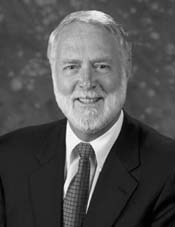 |
|
Other Views by Mike Perricone
WASHINGTON, D.C.-When G. Wayne Clough,
president of the Georgia Institute of Technology,
hosted a visit by President Bush on March 27, he
received strong advice on how to comport himself in
the President's presence.
"Everybody urged me to get as close to him as I could,
so that I would appear in the pictures that were taken,"
Clough told the AAAS Colloquium on Science and Technology Policy.
"Sure enough, the next day, there we were in color on the front page of
the newspapers. But apparently I hadn't gotten quite close enough, because
only half of me appeared in the picture."
Clough, who was named to President Bush's Council of Advisors on Science
and Technology (chaired by OSTP Director John Marburger) in December
2001, compared the photo-op strategy to what he saw as a disappointing
policy trend in the aftermath of last September's terrorist attacks.
"Unfortunately, I feel as if a lot of people are treating this issue the same way,"
Clough said. "They're trying to get as close to it as they can, to make sure
they'll get into the picture."
Clough emphasized that he wasn't opposing national security spending as
a priority, but was seeking a context for other long-term priorities.
Illustrating that challenge, and speaking for the academic sector, he pointed to
some disturbing images in the big picture of U.S. research and development:
Clough pointed to the Internet as the result of research money spent in the
1950s, '60s and '70s. He cited the growth of nanotechnology from 1959, when
Richard Feynman coined the term at a meeting of the American Physical
Society, to its contemporary presence in products ranging from stain-resistant
khaki pants to self-cleaning windows, women's cosmetics, and running boards
for vans.
"By the same token," he countered, "I doubt that General Motors, Eddie Bauer,
or Revlon Cosmetics in their wildest imaginations ever thought of investing in
the frontier physics research that generated the
nanotechnology from which they are now profiting.”
Other speakers noted points for concern in
directions of R&D spending:
Scott Lilly, Minority Staff Director,
House Committee on Appropriations:
Kei Koizumi, Director, R&D Budged and
Policy Program, AAAS:
Conceding wryly that the notion of "balance" in
research spending "has become an interesting
word lately," Clough maintained that balance is
an important principle.
"The problem with advancing some disciplines
at the expense of others is that both the most
important problems and the hot-beds of discovery
and innovation are in the gaps between the
traditional disciplines," Clough said. "…Advances in
biomedical research are grounded in fundamental
research not just in biology, but also in chemistry
and physics, and in chemical and mechanical
engineering, which provide insight into the
operation of living systems. Yet these disciplines
are seeing a declining level of federal support."
|

 "We will be spending money on security whether we like it or not," Clough said.
"The challenge is how to make that a positive for our economy."
"We will be spending money on security whether we like it or not," Clough said.
"The challenge is how to make that a positive for our economy."

 Ben Wu, Deputy Under Secretary for
Technology, U.S. Dept. of Commerce:
Ben Wu, Deputy Under Secretary for
Technology, U.S. Dept. of Commerce: